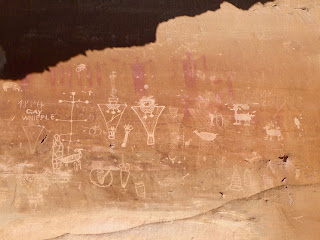We left the delightful Capitol Reef area to drive NW to Moab for our time at Arches and Canyonlands National Parks. There were several stops on our way there. The first part of our journey took us out of the lush canyon of Capitol Reef to expanses of sandy territory. We drove through the tiny town of Hanksville at 4300’ in elevation. South of Hanksville, one can access the northern end of Lake Powell to launch boats. This area also had extensive damage from flooding due to the heavy monsoon rains this past summer.
Past Hanksville is the Goblin Valley State Park. What an interesting place! There were some families with children there that day, and the kids were having a blast.
After lunch in Green River and a brief visit to the John Wesley Powell Museum, our bus driver took us down a dirt road and through an old mostly abandoned mining town to a special place called Sego Canyon. This is one of the most important rock art sites in the whole state. For a complete explanation of this site, click here.
The oldest rock
art is the Barrier Canyon Style that was created between 6000BC to 100 BC.
Next, we have
the Fremont Indian style 600 AD to 1250
AD.
Lastly, the Ute Indians created their art from 1300 AD and 1880 AD.
This last photo is of the Barrier Canyon Style of rock art on nearby private property that we did not visit. It gives an idea of the large size of the figures.
Before arriving at our hotel in Moab, we spent the afternoon enjoying the beautiful vistas from Dead Horse Point State Park, and then on to the Island in the Sky section of Canyonlands. Canyonlands is the largest national park in Utah.This is another area that was unusually lush and green because of the heavy monsoon rains that we had this past summer. This is a view from our bus.
















No comments:
Post a Comment